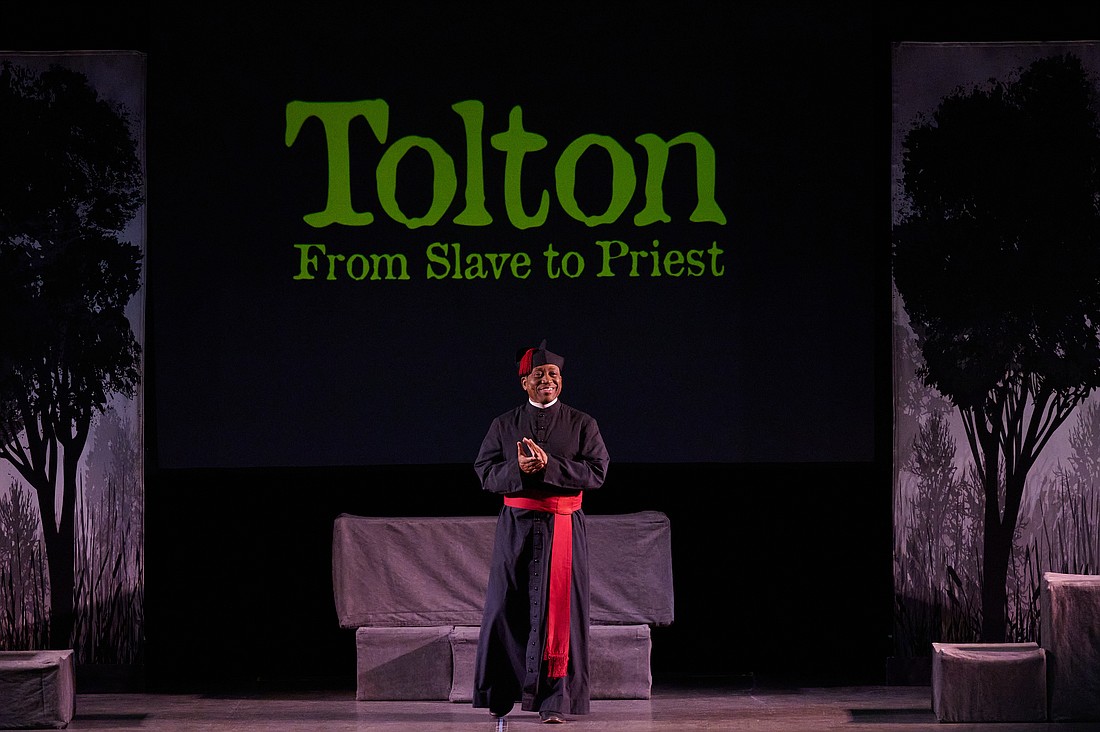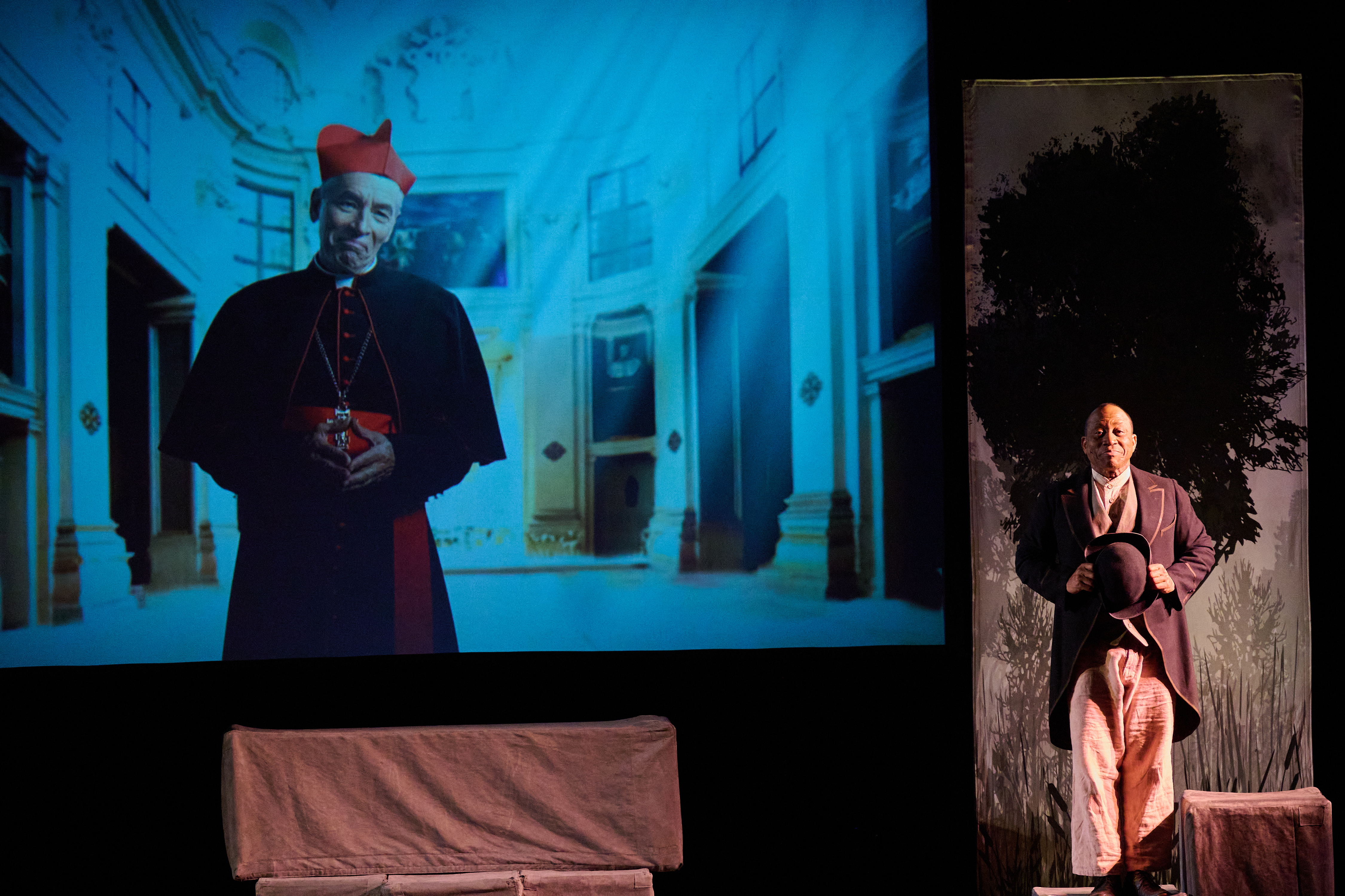'Tolton’ a powerful story of venerable priest’s triumph over prejudice
February 13, 2024 at 12:00 p.m.
|
Updated February 13, 2024 at 11:58 a.m.

The multimedia production “Tolton: From Slave to Priest” gave audience members who gathered Feb. 6 in Notre Dame High School, Lawrenceville, a unique and riveting depiction of America’s first Black priest.
“I never knew about Father Tolton at all,” said Sydney Wiltshire, NDHS junior. “Watching his story made me think I should do some more deep dives into African American history.”
PHOTO GALLERY: "Tolton: From Slave to Priest"
“It was really emotional and heartfelt,” Wiltshire added. “As an African American, when you hear the [audio effect] whipping, and you see how people treated him ... you can put yourself in those shoes. When he was in school, and people were treating him differently ... I can sympathize with that — I’ve had to deal with that at times as well.”
On the Path to Sainthood
Directed by Leonardo Defilippis of St. Luke Productions, the live theatrical one-man drama performed by actor Jim Coleman explored the life of Venerable Augustus Tolton, whose cause for canonization was opened by Cardinal Francis George in 2010.
“It’s not just a Catholic story — it’s the hidden story of African Americans in this country,” said Dr. Ellieen Ingbritsen, the NDHS religion teacher who was instrumental in bringing the play to the school. “I think it’s a great time in Black History Month to feature something that is part of American history that people don’t know about. ... This production talks about how the American system did not welcome people of color in seminaries for religious life – and that, despite this fact, this man’s call was not going to be unanswered.”
Students watched a production during the school day; an evening performance was for the wider community. Music for the performance was composed by Anthony Manfredonia, son of Ewing-based Domestic Church Media co-founders Jim and Cheryl Manfredonia. Anthony Manfredonia attended Catholic schools in the Archdiocese of Philadelphia and graduated from Temple University.
Treatment by Catholics
The production – a combination of live actor Jim Coleman’s performance and interaction with characters recorded on video – unfolded the arc of Tolton’s life, beginning when, at eight years old, he escaped from slavery on a Missouri farm with his mother and siblings. Scenes from Tolton’s childhood in Quincy, Ill., depicted the future priest being shunned by white classmates in the nearby Catholic school, working in a tobacco factory to help support his family, and being drawn to prayer with the example set by his mother.
Although U.S. seminaries declined Tolton’s requests to enter, an Irish priest who had helped tutor him in Latin and German installed him as a teacher for Black students at St. Francis Solanus College, now Quincy University. The priest petitioned Rome for Tolton’s admittance to what is now Pontifical Urbanian University. After his ordination, Father Tolton returned to Quincy, then to Chicago, fighting prejudice to minister to people of all backgrounds, raising funds to build the city’s St. Monica Church and developing a national reputation for preaching. At age 43, Tolton died of heatstroke during the Chicago heatwave of July 1897.
“From the very beginning, the show got you engaged,” said Jailynn Jenkins, junior at NDHS. “It showed how people were really treated then. ... They saw race and didn’t really get to know him. … He really wanted to share the message of the Lord with everybody.”
Dr. Charisse Smith, a member of the NDHS board of governors and chair of the diversity committee, said the drama was “absolutely wonderful – and I was just amazed with how much we don’t know our own history. ... I’ve been Catholic all my life, and never heard this story. ... It kept me very engaged and spoke to me personally; not only was it entertaining, but I was fed as well.”
“Everybody has a story, and that story has a purpose,” Dr. Ingbritsen said. “I’m hoping [the audience] will be curious about the fact that to date we do not have an African American saint yet – his sainthood cause is one of six [African Americans] currently under investigation.”
 The “Tolton” production included actor Jim Coleman’s interaction with recorded video, including this scene of producer Leonardo Defilippis depicting a priest of Rome welcoming Father Tolton to the seminary.
The “Tolton” production included actor Jim Coleman’s interaction with recorded video, including this scene of producer Leonardo Defilippis depicting a priest of Rome welcoming Father Tolton to the seminary.
The Church needs quality Catholic journalism now more than ever. Please consider supporting this work by signing up for a SUBSCRIPTION (click HERE) or making a DONATION to The Monitor (click HERE). Thank you for your support.
Related Stories
Sunday, December 14, 2025
E-Editions
Events
The multimedia production “Tolton: From Slave to Priest” gave audience members who gathered Feb. 6 in Notre Dame High School, Lawrenceville, a unique and riveting depiction of America’s first Black priest.
“I never knew about Father Tolton at all,” said Sydney Wiltshire, NDHS junior. “Watching his story made me think I should do some more deep dives into African American history.”
PHOTO GALLERY: "Tolton: From Slave to Priest"
“It was really emotional and heartfelt,” Wiltshire added. “As an African American, when you hear the [audio effect] whipping, and you see how people treated him ... you can put yourself in those shoes. When he was in school, and people were treating him differently ... I can sympathize with that — I’ve had to deal with that at times as well.”
On the Path to Sainthood
Directed by Leonardo Defilippis of St. Luke Productions, the live theatrical one-man drama performed by actor Jim Coleman explored the life of Venerable Augustus Tolton, whose cause for canonization was opened by Cardinal Francis George in 2010.
“It’s not just a Catholic story — it’s the hidden story of African Americans in this country,” said Dr. Ellieen Ingbritsen, the NDHS religion teacher who was instrumental in bringing the play to the school. “I think it’s a great time in Black History Month to feature something that is part of American history that people don’t know about. ... This production talks about how the American system did not welcome people of color in seminaries for religious life – and that, despite this fact, this man’s call was not going to be unanswered.”
Students watched a production during the school day; an evening performance was for the wider community. Music for the performance was composed by Anthony Manfredonia, son of Ewing-based Domestic Church Media co-founders Jim and Cheryl Manfredonia. Anthony Manfredonia attended Catholic schools in the Archdiocese of Philadelphia and graduated from Temple University.
Treatment by Catholics
The production – a combination of live actor Jim Coleman’s performance and interaction with characters recorded on video – unfolded the arc of Tolton’s life, beginning when, at eight years old, he escaped from slavery on a Missouri farm with his mother and siblings. Scenes from Tolton’s childhood in Quincy, Ill., depicted the future priest being shunned by white classmates in the nearby Catholic school, working in a tobacco factory to help support his family, and being drawn to prayer with the example set by his mother.
Although U.S. seminaries declined Tolton’s requests to enter, an Irish priest who had helped tutor him in Latin and German installed him as a teacher for Black students at St. Francis Solanus College, now Quincy University. The priest petitioned Rome for Tolton’s admittance to what is now Pontifical Urbanian University. After his ordination, Father Tolton returned to Quincy, then to Chicago, fighting prejudice to minister to people of all backgrounds, raising funds to build the city’s St. Monica Church and developing a national reputation for preaching. At age 43, Tolton died of heatstroke during the Chicago heatwave of July 1897.
“From the very beginning, the show got you engaged,” said Jailynn Jenkins, junior at NDHS. “It showed how people were really treated then. ... They saw race and didn’t really get to know him. … He really wanted to share the message of the Lord with everybody.”
Dr. Charisse Smith, a member of the NDHS board of governors and chair of the diversity committee, said the drama was “absolutely wonderful – and I was just amazed with how much we don’t know our own history. ... I’ve been Catholic all my life, and never heard this story. ... It kept me very engaged and spoke to me personally; not only was it entertaining, but I was fed as well.”
“Everybody has a story, and that story has a purpose,” Dr. Ingbritsen said. “I’m hoping [the audience] will be curious about the fact that to date we do not have an African American saint yet – his sainthood cause is one of six [African Americans] currently under investigation.”
 The “Tolton” production included actor Jim Coleman’s interaction with recorded video, including this scene of producer Leonardo Defilippis depicting a priest of Rome welcoming Father Tolton to the seminary.
The “Tolton” production included actor Jim Coleman’s interaction with recorded video, including this scene of producer Leonardo Defilippis depicting a priest of Rome welcoming Father Tolton to the seminary.
The Church needs quality Catholic journalism now more than ever. Please consider supporting this work by signing up for a SUBSCRIPTION (click HERE) or making a DONATION to The Monitor (click HERE). Thank you for your support.










